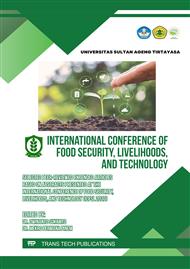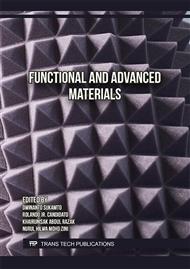[1]
H. Xie, B. Cui, S. Hao, S. Li, X. Jia, and W. Wang, Composites Science and Technology, 230, 109728 (2022).
Google Scholar
[2]
S.H. Lee, W.C. Lum, J.G. Boon, L. Kristak, P. Antov, M. Pędzik, T. Rogoziński, H.R. Taghiyari, M.A.R. Lubis, W. Fatriasari, S.M. Yadav, A. Chotikhun, and A. Pizzi, Journal of Materials Research and Technology, 20, 4630–4658 (2022).
DOI: 10.1016/j.jmrt.2022.08.166
Google Scholar
[3]
G. Singh and S.K. Arya, Journal of Cleaner Production, 291, 125278 (2021).
Google Scholar
[4]
R. Khandanlou, M.B. Ahmad, K. Shameli, M.Z. Hussein, N. Zainuddin, and K. Kalantari, Res Chem Intermed, 41, 6371–6384 (2015).
DOI: 10.1007/s11164-014-1746-y
Google Scholar
[5]
D. Kaur, N.K. Bhardwaj, and R.K. Lohchab, Waste Management, 60, 127–139 (2017).
Google Scholar
[6]
S. Hu, J. Gu, F. Jiang, and Y.-L. Hsieh, ACS Sustainable Chem. Eng., 4, 728–737 (2016).
Google Scholar
[7]
S. Halvarsson, H. Edlund, and M. Norgren, Ind. Eng. Chem. Res., 49, 1428–1435 (2010).
Google Scholar
[8]
A.C.F. Louis, S. Venkatachalam, and S. Gupta, Industrial Crops and Products, 179, 114695 (2022).
Google Scholar
[9]
N.A.M. Razali, W.M.H.W. Ya'acob, R.A.A. Rusdi, and F.A. Aziz, Materials Science Forum, 888, 244–247 (2017).
Google Scholar
[10]
T. Chiranjeevi, S. Jose, B. Ramachandrarao, and H. Ravindra Velankar, Energy Fuels, 34, 7170–7182 (2020).
DOI: 10.1021/acs.energyfuels.0c00967
Google Scholar
[11]
S. De, S. Mishra, E. Poonguzhali, M. Rajesh, and K. Tamilarasan, International Journal of Biological Macromolecules, 145, 795–803 (2020).
DOI: 10.1016/j.ijbiomac.2019.10.068
Google Scholar
[12]
J. Gu and Y.-L. Hsieh, ACS Sustainable Chem. Eng., 5, 1730–1737 (2017).
Google Scholar
[13]
L. Dong, J. Wu, C. Zhou, C.J. Xu, B. Liu, D. Xing, G. Xie, X. Wu, Q. Wang, G. Cao, and N. Ren, International Journal of Hydrogen Energy, 45, 1578–1587 (2020).
DOI: 10.1016/j.ijhydene.2019.11.037
Google Scholar
[14]
J. Peng, A.E.-F. Abomohra, M. Elsayed, X. Zhang, Q. Fan, and P. Ai, Journal of Cleaner Production, 230, 775–782 (2019).
Google Scholar
[15]
X. Dai, Y. Hua, L. Dai, and C. Cai, Bioresource Technology, 293, 122043 (2019).
Google Scholar
[16]
Z. Tang, Y. Liang, M. Wang, H. Zhang, and X. Wang, Industrial Crops and Products, 180, 114729 (2022).
Google Scholar
[17]
M.A. Jamaludin, S.A. Bahari, M.N. Zakaria, and N.S. Saipolbahri, Journal of the Korean Wood Science and Technology, 48, 22–31 (2020).
Google Scholar
[18]
B. Pang, T. Zhou, X.-F. Cao, B.-C. Zhao, Z. Sun, X. Liu, Y.-Y. Chen, and T.-Q. Yuan, Journal of Cleaner Production, 375, 134037 (2022).
Google Scholar
[19]
P. Garside and P. Wyeth, Studies in Conservation, 48, 269–275 (2003).
Google Scholar
[20]
X. Li, Z. Cai, J.E. Winandy, and A.H. Basta, Bioresource Technology, 101, 4662–4666 (2010).
Google Scholar
[21]
J.C. Alcántara, I. González, M.M. Pareta, and F. Vilaseca, Materials, 13, 2138 (2020).
Google Scholar
[22]
H. Xu, M. Dun, Z. Zhang, L. Zhang, W. Shan, and W. Wang, Polymers, 14, 2243 (2022).
Google Scholar
[23]
F. Bilo, S. Pandini, L. Sartore, L.E. Depero, G. Gargiulo, A. Bonassi, S. Federici, and E. Bontempi, Journal of Cleaner Production, 200, 357–368 (2018).
DOI: 10.1016/j.jclepro.2018.07.252
Google Scholar
[24]
S. Navaee-Ardeh, J. Mohammadi-Rovshandeh, and M. Pourjoozi, Bioresource Technology, 92, 65–69 (2004).
DOI: 10.1016/j.biortech.2003.07.006
Google Scholar



